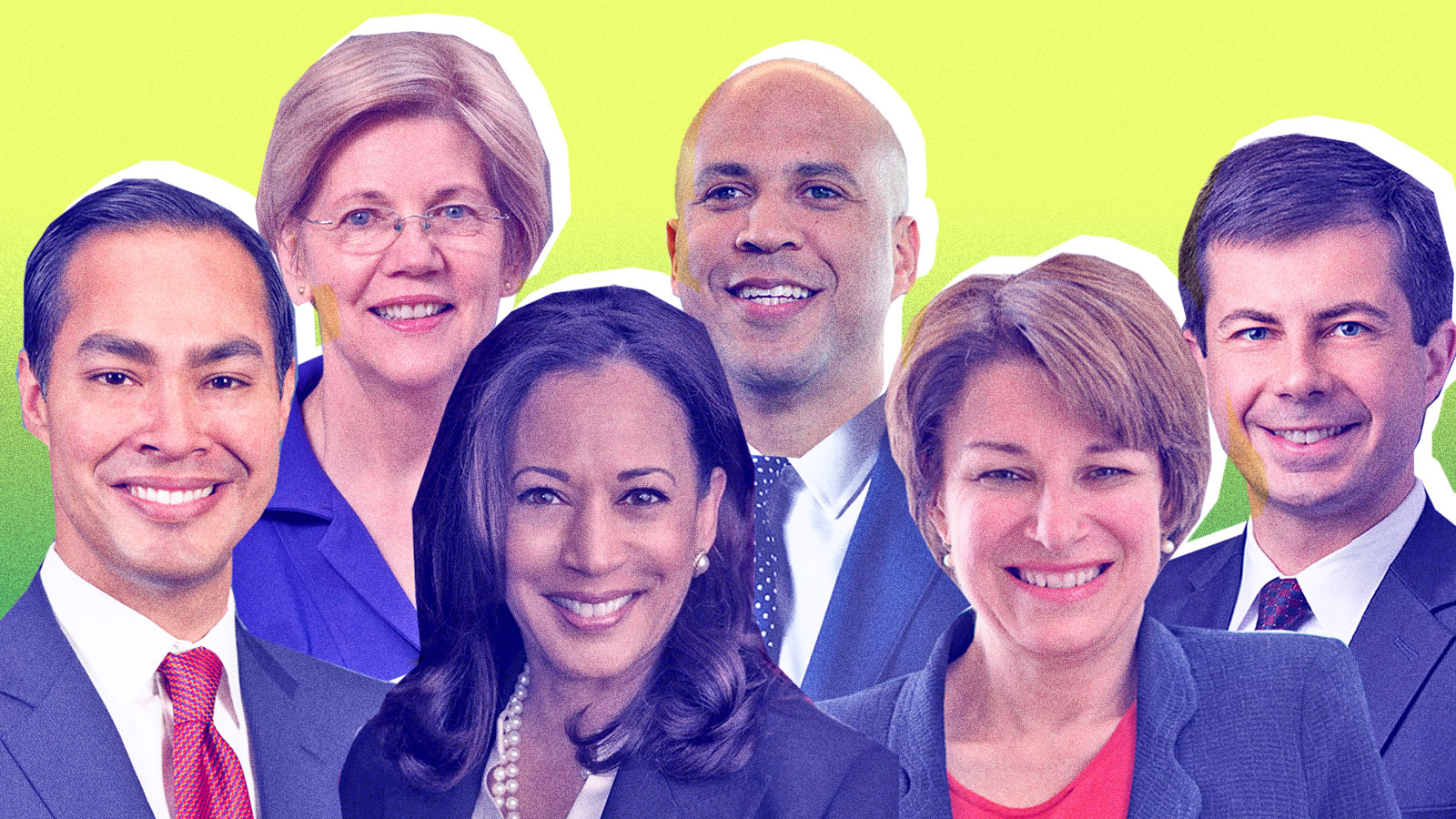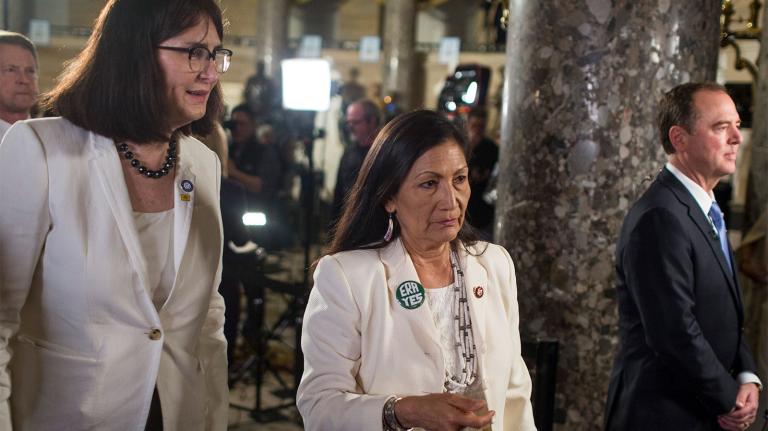Though Washington Governor Jay Inslee, the gone-but-not-forgotten climate candidate, is out of the race, climate change will take center stage on Wednesday at CNN’s seven-hour Town Hall, which is really just back-to-back interviews with ten candidates. Some of them— Joe Biden, Bernie Sanders, Beto O’Rourke, and Andrew Yang — released detailed climate plans weeks or even months ago, so they’ll presumably have an easy time preparing for the town hall. Other hopefuls seemed like students scrambling to hand in their homework before the event. Six candidates released their long-awaited climate plans this week, which means that even if the CNN event is a total snore, the cable network gets credit for forcing the procrastinators to come up with something to tackle, you know, what’s arguably the greatest threat to humanity.
Too busy to skim? Read ahead for highlights from the plans that dropped this week.
Amy Klobuchar
On Sunday, Senator Amy Klobuchar announced a $1 trillion climate plan in which she promised to “take aggressive executive action to confront” the growing issue.
Although many candidates have made broad promises for their first days in office — such as rejoining the Paris Climate Agreement — Klobuchar also plans on making specific changes within her first three months in office. During the first 100 days of her administration, Senator Klobuchar promises she will “pass sweeping legislation” that would put the U.S. on a path to net-zero emissions by 2050, slash the federal government’s hefty carbon footprint, and reinstate the National Climate Assessment Advisory Committee that President Trump let expire.
She also plans to restore the Obama-era Clean Power Plan, which sets emission standards for states, during her first 100 days and bring back Obama-era fuel-economy standards for cars. Like a handful of other candidates, Klobuchar also wants a tax on carbon.
Cory Booker
Senator Cory Booker unveiled his plan on Tuesday. The Democratic hopeful wants to invest $3 trillion over a decade with the goal of getting the economy carbon-neutral economy by 2045 if elected president.
Like Klobuchar, Booker would reinstate and strengthen fuel standards for cars and rejoin the Paris accord. The senator from New Jersey also wants to scuttle the Keystone Pipeline and Dakota Access Pipeline and “phase out fracking” (though he doesn’t suggest a deadline or mechanism for doing so). Booker would create a “progressive climate dividend” paid to Americans through new carbon fees on fossil fuel producers (which sounds a lot like Andrew Yang’s “Freedom Dividend”).
Booker would earmark $400 billion to research clean energy technology and $100 billion for existing Department of Agriculture programs that make farms more climate-resilient.
At the center of Booker’s plan is a focus on environmental justice. To “invest in communities long left behind,” Booker’s plan calls for the creation of a White House-coordinated Environmental Justice Fund, which would commit $50 billion a year(!) to those places. The fund would include a nationwide lead remediation program to replace lead water pipes in every school and home. (Booker’s hometown of Newark, New Jersey, where he served as mayor, has been grappling with an ongoing lead crisis.)
“We are facing a dual crisis of climate change and economic inequality,” Booker said in a statement. “Without immediate action, we risk an incredible human toll from disasters, health impacts, rising national security threats, and trillions of dollars in economic losses.”
Elizabeth Warren
If all the other candidates are scrambling to get their homework in on time, Senator Elizabeth Warren is more like the eager straight-A student turning in extra credit. She’s already put out a public lands proposal and a green manufacturing proposal, among others. In the plan she released on Tuesday, Warren follows in Inslee’s footsteps with a 10-year target to achieve 100-percent clean energy.
An investment of $3 trillion, paid for in part by reversing Trump’s tax cuts for the wealthiest people and giant corporations, would create millions of clean jobs and “leverage additional trillions in private investment,” according to the plan.
Warren hopes to make all new commercial and residential buildings emit zero carbon by 2028, most vehicles release zero carbon by 2030, and electricity generation fully renewable and zero-emission by 2035.
The Massachusetts senator says she hopes to leave no worker — including those in coal and other fossil-fuel industries — behind in the shift to a greener economy. Warren plans to provide them with “financial security” by way of early retirement benefits, job training, union protections and benefits, as well as guaranteed wage and benefit parity for workers affected by the transition.
Julián Castro
Warren isn’t the only one channeling the ghost of Inslee’s policy proposals. Former Housing Secretary Julian Castro dropped his plan on Tuesday, too, and also worked in several of Inslee’s ideas. Like Inslee and Warren before him, Castro plans to put out a multi-pronged climate plan; the portions released Tuesday are the first two of five parts.
His $10 trillion proposal, dubbed “People and Planet First” aligns with the ethos of the Green New Deal resolution, focusing on both resiliency and justice: “People do not live their lives in silos and so our plan is intersectional,” it says. “We will build a 100 percent clean energy economy that both combats the climate crisis and tackles structural inequality.” Castro says it will create 10 million “good-paying jobs,” which sounds like some Green New Deal stuff, indeed.
Castro’s proposed timeline includes phasing out coal-fired power plants and reaching a carbon-neutral electricity grid by 2030, reaching net-zero emissions in the U.S. by 2045, and “rallying the international community” to get net-zero emissions for the planet by 2050 (a unique aspect of Castro’s proposal). He promises that on his first day in office, he’ll end all taxpayer subsidies of fossil fuels and all extraction and exploration on public lands.
In his first 100 days, he’ll propose civil rights legislation that would require all federal actions to be reviewed to see what sort of health and environmental impact it would have on marginalized communities. Similar to Inslee’s justice plan, Castro would empower the EPA to sue polluters and give individuals and communities the ability to sue companies that disproportionately pollute in marginalized or low-income areas. And he’d create a special “climate” refugee designation for those displaced by the crisis.
Pete Buttigieg
Pete Buttigieg, the mayor of South Bend, Indiana, rolled up his sleeves and released his 18-page climate plan early Wednesday morning. The detailed, practical plan shines when it comes to farming, unions, and making middle America both more resilient and an epicenter of solutions. We know Mayor Pete loves to talk about soil, and his plan doesn’t disappoint.
“A farmer practicing smart soil management in Iowa should be as much a symbol of combating climate change as someone driving an electric vehicle in Los Angeles,” he wrote in a statement accompanying the plan.
The mayor’s proposal calls for a $200 billion transition fund to retrain displaced workers, such as coal miners, whose jobs would be phased out by the shift to a green economy. He also emphasizes the importance of strengthening unions and worker protections. And of course, to ensure the “American Heartland” isn’t left behind, he plans to build “Regional Resilience Hubs,” with $5 billion in annual grants to invest in efforts to mitigate climate disasters, such as the floods that soaked the Midwest earlier this year.
Like Booker and others, he proposes an economy-wide carbon tax, with the revenue going directly back to Americans. And like Biden, Buttigieg says he will use the power of American diplomacy and leadership to influence other countries to meet global climate goals and restore America’s “damaged” credibility internationally.
His proposal didn’t come with a price tag, but all in, it should cost about $1.5 to $2 trillion, a campaign staffer told Grist. The spokesperson also said the proposal will be updated as the campaign cycle progresses: “This is not the last that you will hear from him in climate.“
Mayor Pete’s proposed timeline: Double clean electricity use by 2025. Get to zero emissions from passenger vehicles and electricity generation by 2035. And achieve fully net-zero emissions in the U.S. by 2050. He’s also promised to quadruple federal clean energy research and development funding to $25 billion per year by 2025.
Kamala Harris
California Senator Kamala Harris was one of the last to release her plan, which dropped early Wednesday morning. She confronts the topic with her signature prosecutorial style, drawing on her experience going up against fossil fuel corporations as California’s attorney general by promising to take polluters to court.
Her proposed actions include strengthening the EPA’s ability to legally enforce environmental policies and directing the Department of Justice to “address both cumulative and legacy pollution” — potentially providing relief for communities that often find themselves burdened by living near power plants, pipelines, or other industry.
Harris commits $10 trillion in public and private funding to her plan, the same as Castro, which is near the top of the pack. (Bernie Sanders tops the list with a plan to spend some $16.3 trillion solely in federal dollars.) In her 27-page “Climate Plan for the People,” Harris says she’ll target 100 percent renewable electricity by 2030 and net-zero vehicle emissions by 2035. She commits to reaching a 100 percent clean energy economy and meet the Paris accord goals by 2045.
Throughout the plan she places a strong emphasis on environmental justice, relying heavily on the Climate Equity Act draft legislation she and House Rep. Alexandria Ocasio-Cortez announced in July. Interestingly, she also name-drops Senator Booker’s Environmental Justice Act, saying she’ll work with Congress to get it passed. Finally, Harris promises to create an Office of Climate and Environmental Justice Accountability to ensure frontline communities have a voice in the government’s decision-making.



